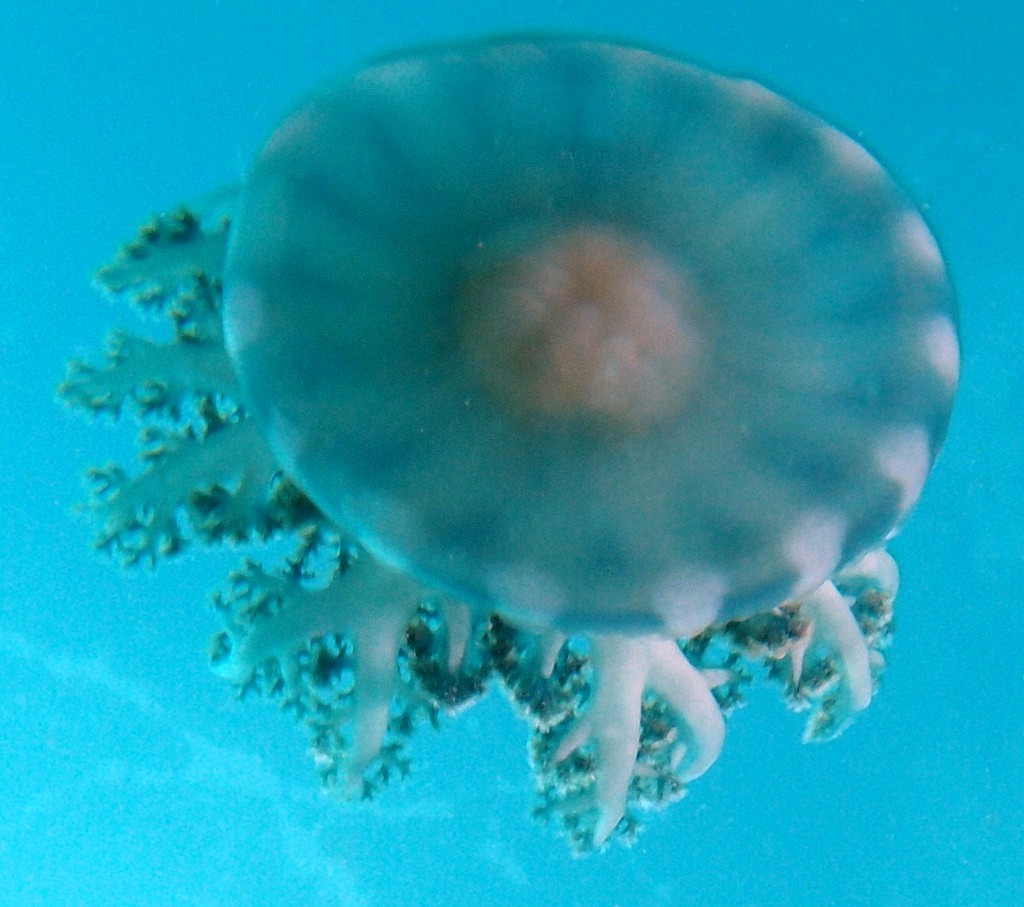CASSIOPEA ANDROMEDA - (FORSSKAL, 1775)
Cnidaria (Phylum) > Scyphozoa (Class) > Discomedusae (Subclass) > Rhizostomeae (Order) > Kolpophorae (Suborder) > Cassiopeidae (Family) > Cassiopea (Genus)
Upside down jellyfish, Méduse à l'envers indo-pacifique,
--------------------------------
Description
Bell is yellow-brown with white or pale spots and streaks. Arms are also brownish with extended frilly tentacles. Max length : 30.0 cm WD.
Distribution
Indo-Pacific: Papua New Guinea and Hawaiian Islands. Reported from New Caledonia.
Biology
Host of Hyperia galba (Montagu, 1815). Typically found in shallow lagoons, intertidal sand or mud flats, and around mangroves. This jellyfish, many times mistaken for a sea anemone, usually has its mouth upward on the bottom.
Alimentation and strategies
Cassiopea andromeda is carnivorous and eats small animals from the sea or just pieces of them after it paralyzes its prey with its mucous and nematocysts when they are released. This jellyfish also lives in a symbiotic relationship with photosynthetic dinoflagellate algae, the Zooxanthellae, and with shrimps. The Zooxanthellae live in the tissues of the ventral surface of its body and it is the responsible for the color of it. As the Zooxanthellaeon gets food for the Cassiopea andromeda, in response, it gets the sunlight that is necessary for the photosynthetic dinoflagellate algae. Therefore, the shrimp has a different symbiotic relationship with this jellyfish. It lives in its tentacles and protects it by taking the parasites off. In exchange, the Cassiopea andromeda mainly offers protection to the shrimp from the environment. This symbiotic relationship is called mutualism, where both species benefit from their interactions.
Reproduction
As a cnidarian, this jellyfish has an asexual and sexual reproduction. It reproduces by budding when it is in a polyp form. When it is in a medusa form, it reproduces sexually. The medusa female produces the eggs and keep them. As the male produces the sperm and releases them in the water, the female uses its tentacles to bring the sperm to fertilize its eggs.
Upside down jellyfish, Méduse à l'envers indo-pacifique,
--------------------------------
Description
Bell is yellow-brown with white or pale spots and streaks. Arms are also brownish with extended frilly tentacles. Max length : 30.0 cm WD.
Distribution
Indo-Pacific: Papua New Guinea and Hawaiian Islands. Reported from New Caledonia.
Biology
Host of Hyperia galba (Montagu, 1815). Typically found in shallow lagoons, intertidal sand or mud flats, and around mangroves. This jellyfish, many times mistaken for a sea anemone, usually has its mouth upward on the bottom.
Alimentation and strategies
Cassiopea andromeda is carnivorous and eats small animals from the sea or just pieces of them after it paralyzes its prey with its mucous and nematocysts when they are released. This jellyfish also lives in a symbiotic relationship with photosynthetic dinoflagellate algae, the Zooxanthellae, and with shrimps. The Zooxanthellae live in the tissues of the ventral surface of its body and it is the responsible for the color of it. As the Zooxanthellaeon gets food for the Cassiopea andromeda, in response, it gets the sunlight that is necessary for the photosynthetic dinoflagellate algae. Therefore, the shrimp has a different symbiotic relationship with this jellyfish. It lives in its tentacles and protects it by taking the parasites off. In exchange, the Cassiopea andromeda mainly offers protection to the shrimp from the environment. This symbiotic relationship is called mutualism, where both species benefit from their interactions.
Reproduction
As a cnidarian, this jellyfish has an asexual and sexual reproduction. It reproduces by budding when it is in a polyp form. When it is in a medusa form, it reproduces sexually. The medusa female produces the eggs and keep them. As the male produces the sperm and releases them in the water, the female uses its tentacles to bring the sperm to fertilize its eggs.
